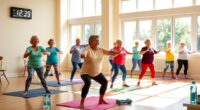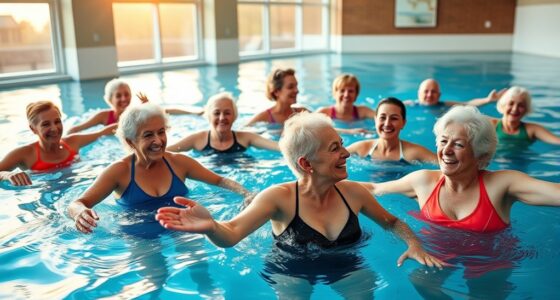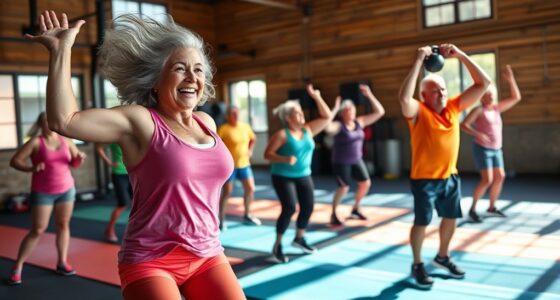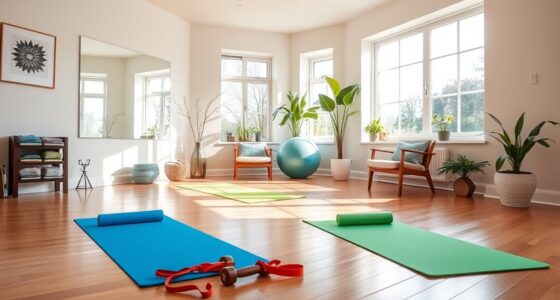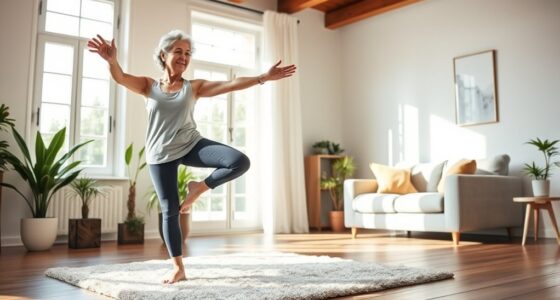Personal trainers for the elderly offer tailored fitness solutions that cater to your unique needs. They create customized exercise programs to improve your strength, flexibility, and balance, ensuring a safe and effective workout. With professional guidance, you can combat age-related declines while enjoying social interaction in group sessions. This approach not only enhances your physical health but also boosts your mental well-being and quality of life. Discover more about how to start your fitness journey.
Key Takeaways
- Personalized fitness programs for seniors assess individual needs, ensuring safe and effective exercise tailored to unique limitations and goals.
- Working with personal trainers provides customized plans that enhance motivation, accountability, and consistent engagement in physical activity.
- Trainers focus on improving functional strength, mobility, balance, and flexibility, addressing age-related declines in muscle mass and bone density.
- Safety is prioritized through exercise modifications, low-impact activities, and fall prevention strategies to reduce risks associated with aging.
- Group training sessions foster community support, enhancing social interactions and promoting mental well-being alongside physical health benefits.
The Importance of Personalized Fitness for Seniors
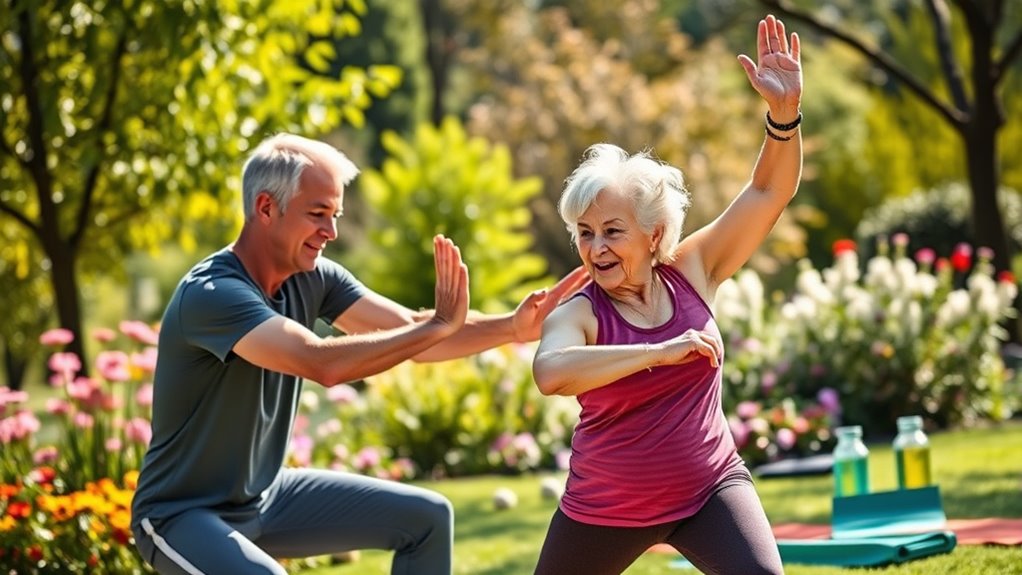
As you age, your fitness needs change, making personalized fitness programs essential for seniors. These tailored programs focus on your unique needs and limitations, enhancing safety and effectiveness in your exercise routine.
Through assessments of your fitness level, medical history, and personal goals, trainers develop customized fitness solutions that help you stay motivated and committed to regular physical activity. Additionally, incorporating omega-3 fatty acids into your diet can further support your cognitive function as you engage in physical fitness. A well-organized home environment can also enhance focus and productivity, promoting a more effective fitness routine. Engaging in regular physical activity helps improve overall cognitive function, which is crucial as you age. Moreover, engaging in strength training can significantly enhance your overall fitness and independence.
Specific exercises in these programs emphasize strength training, flexibility, and balance, all vital for maintaining independence and reducing fall risks.
Experienced trainers provide modifications and techniques that cater to the challenges you may face, creating a supportive environment.
With regularly updated training sessions, personalized programs foster long-term commitment to your overall health and well-being, ensuring you thrive as you age. Furthermore, incorporating home improvement strategies can create an environment that supports your fitness journey and enhances your overall quality of life.
Benefits of Working With a Personal Trainer

Working with a personal trainer offers numerous advantages that can greatly enhance your fitness journey as you age. Personal trainers create plans tailored to your needs, focusing on improving mobility, strength, and balance. This not only helps enhance stability but also guarantees you’re engaging in safe exercises suitable for your specific needs. Additionally, trainers often emphasize the importance of regular veterinary check-ups, which ensures that you maintain overall health and wellness as you engage in physical activities. Moreover, they may recommend incorporating freshly squeezed juices into your diet to boost hydration and nutrients. Juice cleanses may also be suggested to support detoxification and weight management. Furthermore, personal trainers provide motivation and accountability, helping you stay committed to regular exercise and achieve measurable health goals. They often foster a supportive community, encouraging camaraderie that boosts your overall well-being. Regular engagement in physical activity is crucial for promoting lifelong health and can significantly impact your well-being as you age. Finally, incorporating regular exercise with a trainer can improve your mood and cognitive function, contributing to a higher quality of life. Additionally, trainers often utilize essential accessories that are specifically chosen to enhance the safety and effectiveness of your workouts.
| Benefits | Description |
|---|---|
| Customized Plans | Tailored to your needs for ideal results |
| Motivation | Accountability to keep you committed |
| Safety | Exercises designed with your specific needs in mind |
| Community Support | Foster camaraderie for enhanced motivation |
Understanding the Unique Needs of Older Adults
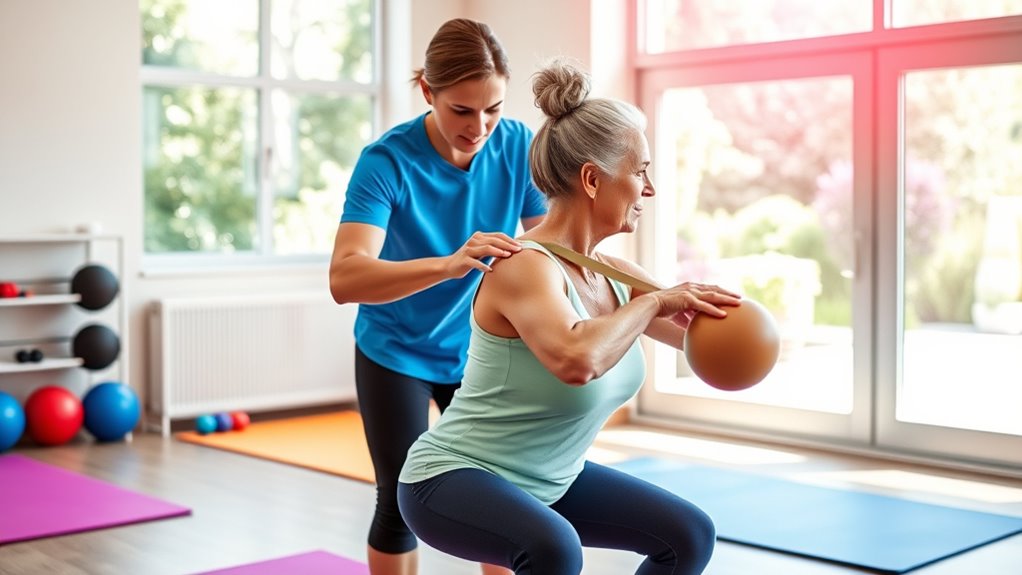
Understanding the unique needs of older adults is essential for creating effective fitness programs. As a senior, you may face age-related declines in muscle mass, bone density, and balance. That’s why tailored fitness programs are vital. A personal trainer specializing in senior fitness will focus on improving functional strength and mobility, helping you maintain independence and reduce fall risks. Customized regimens can address your physical and mental barriers, such as fears of injury or the belief that it’s too late to start. Additionally, integrating home improvement strategies can further enhance your safety and comfort while exercising at home. Understanding the importance of long-term financial planning can also help ensure you have the resources needed to support your fitness journey. Furthermore, having a clear understanding of maintenance rights can provide reassurance when planning for future health and fitness expenses. It’s also important to consider the causes of difficult behavior that may arise during exercise, as addressing these can enhance the overall experience for seniors. Additionally, incorporating multi-functional gear into workout routines can maximize space and efficiency in home exercise environments.
Tailored Exercise Programs for Enhanced Mobility

Tailored exercise programs for seniors enhance mobility by focusing on individual needs and capabilities.
These personalized fitness regimens are designed after customized assessments of your physical abilities, medical history, and specific goals. By incorporating specialized strength, flexibility, and balance exercises, these fitness plans promote gradual and safe progression. Additionally, regular participation in these tailored exercise programs can help improve indoor air quality as they encourage an active lifestyle that supports overall health. Engaging in regular physical activity is also known to support health and wellness by preventing common health concerns. Furthermore, maintaining a balanced diet is essential for maximizing the benefits of these fitness routines. Incorporating educational toys into your routine can also enhance cognitive engagement, promoting overall brain health.
Personalized fitness regimens are crafted to suit your unique abilities and goals, ensuring safe and gradual progression.
Functional movements mimic daily activities, helping you regain independence and confidence in your mobility. Regular participation in these tailored exercise programs can notably improve your overall coordination and stability, reducing the risk of falls.
Furthermore, focusing on enhancing mobility can lead to increased joint mobility and decreased stiffness, ultimately supporting healthy aging and improving your quality of life. Engaging in stress management techniques can also complement your fitness journey by promoting mental well-being.
Embrace a fitness plan that works for you!
Safety Considerations in Senior Fitness Training

When you’re training seniors, safety has to come first. You should assess their physical limitations, make proper exercise modifications, and implement fall prevention strategies to guarantee a safe environment. Additionally, understanding the importance of community collaboration can enhance the effectiveness of fitness programs tailored for elderly individuals. Incorporating personalized exercise plans can further ensure that activities are suitable for each individual’s needs and capabilities. Regularly updating these plans is also essential to adapt to any changes in their health status. Furthermore, being aware of common financial terms can help seniors make informed decisions about investing in their health and wellness. Engaging in mindfulness practices can also support seniors in maintaining focus and reducing anxiety during their fitness routines.
Assessing Physical Limitations
Evaluating physical limitations in seniors is essential for creating safe and effective exercise programs. When you’re reviewing physical limitations, start by going over the individual’s medical history and current fitness level. This helps identify specific constraints, allowing you to develop a customized fitness plan that caters to their needs.
Safety considerations are paramount; many seniors face challenges with balance and coordination, increasing the risk of falls. Prioritize exercises that enhance strength and flexibility while avoiding high-impact activities that might worsen existing injuries. Additionally, incorporating emotional support can help seniors feel more confident and motivated in their fitness journey. Recognizing patterns of emotional coldness can also enhance the overall well-being of seniors as they engage in fitness activities. Regular updates and adjustments to effective co-parenting plans can provide a supportive framework for seniors, ensuring they feel connected and secure in their routine.
Regularly reevaluate their physical capabilities to adapt the fitness program as their strength and endurance improve. This guarantees safety and effectiveness, making exercise an enjoyable and rewarding experience for seniors.
Proper Exercise Modifications
To guarantee safety and effectiveness in senior fitness training, it’s important to implement proper exercise modifications that cater to individual limitations.
Focus on low-impact exercises, like swimming or walking, which protect joints while enhancing cardiovascular health.
When designing strength training routines, use lighter weights with higher repetitions to build muscle safely.
Incorporate balance exercises, such as tai chi or stability ball workouts, to improve coordination and reduce fall risks.
Regular assessments are vital to adjust exercise programs, ensuring that modifications continue to meet evolving fitness levels and health needs.
Fall Prevention Strategies
Implementing proper exercise modifications not only enhances safety but also lays the groundwork for effective fall prevention strategies in senior fitness training.
Tailored balance and stability exercises are essential in reducing the risk of falls by improving coordination. Incorporating functional strength training helps you maintain muscle mass and bone density, important for overall stability.
Regular assessments allow personal trainers to create a personalized fitness program that addresses your unique balance challenges and mobility issues.
Safety considerations, like wearing supportive footwear and keeping a clutter-free space, further enhance these strategies.
Joining group training sessions can also provide community support, boosting motivation and accountability, which are critical for maintaining a consistent and safe exercise routine tailored to your elderly fitness needs.
Building Strength and Balance Through Customized Plans
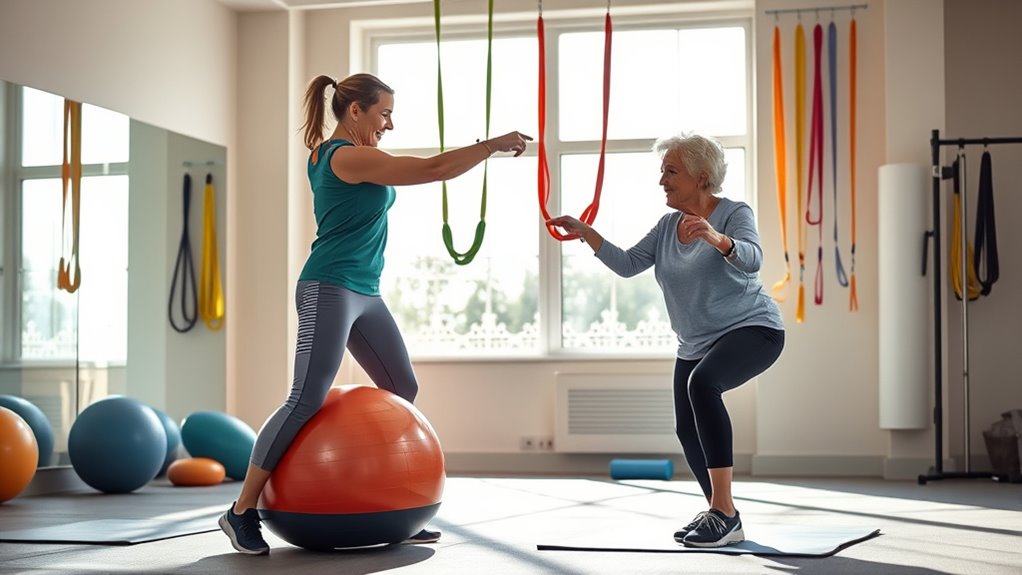
As you age, building strength and balance becomes essential for maintaining your independence and reducing fall risks.
Personal trainers can create customized programs that focus on enhancing your coordination and muscle mass through targeted exercises.
With the right plan, you’ll not only improve your daily mobility but also boost your overall health.
Importance of Strength Training
Strength training plays an essential role in maintaining your independence and quality of life as you age. For seniors, engaging in a personalized exercise program is vital for several reasons:
- It helps counteract age-related muscle loss, preserving the strength necessary for daily activities.
- Customized strength training reduces the risk of falls by enhancing balance and stability, tailored to your specific needs.
- Regular participation boosts bone density, important for preventing osteoporosis and minimizing fracture risks.
Moreover, research shows that incorporating strength training can improve your mental well-being and boost confidence, positively impacting your overall quality of life.
Enhancing Balance and Coordination
Maintaining your strength is just the beginning; enhancing balance and coordination is equally important for staying active and independent as you age. A personal trainer can create a tailored fitness plan that includes specific exercises like tai chi and leg raises to improve your stability and strength.
Engaging in regular balance training can reduce your fall risk by 30-40%, ensuring you navigate your environment safely. Incorporating agility drills, such as side steps and heel-to-toe walks, further enhances your coordination.
Customized Program Benefits
- Tailored to Your Goals: Each plan focuses on your individual strengths and limitations, allowing for targeted strength training exercises.
- Flexibility and Balance: Specific exercises enhance your mobility, helping you maintain an active lifestyle.
- Ongoing Assessments: Regular check-ins allow for adjustments that keep you challenged and engaged.
Promoting Mental Well-Being and Quality of Life
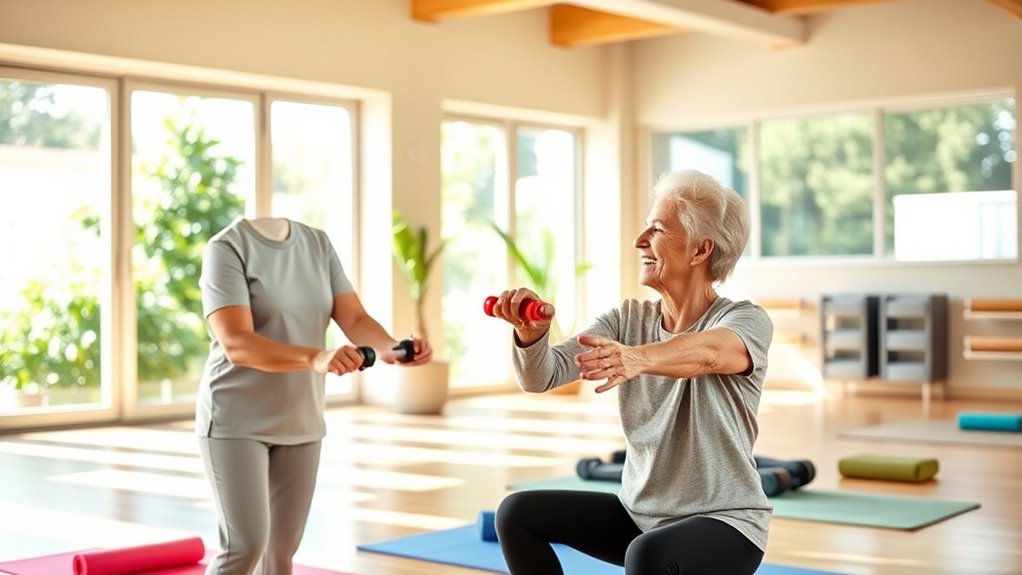
When you engage in regular exercise with a personal trainer, you’re not just working on your physical health; you’re also greatly enhancing your mental well-being.
Tailored fitness programs can markedly reduce symptoms of anxiety and depression, thanks to the endorphins released during workouts. These personalized fitness plans improve cognitive function, helping to mitigate age-related memory decline.
Tailored fitness programs significantly alleviate anxiety and depression while enhancing cognitive function and memory health.
Plus, social interactions during group sessions foster a sense of community, combating loneliness and boosting emotional health. As you participate in active aging, you’ll notice improved quality of life through increased energy levels and better sleep patterns.
Ultimately, consistent exercise empowers you to take control of your health, enhancing both your self-esteem and overall liveliness.
Getting Started With Your Fitness Journey

Starting your fitness journey can feel overwhelming, but it doesn’t have to be. Here’s how to get started on the right foot for healthy aging:
- Assess Your Fitness Level: Begin with a free healthy aging strategy session to evaluate your current abilities and set personal goals tailored to your needs.
- Consult a Personal Trainer: Work with experienced trainers specializing in senior fitness to create a safe and effective exercise program that addresses your unique limitations.
- Engage in Varied Exercises: Focus on strength, flexibility, balance, and mobility to counteract age-related declines.
Consider virtual training for convenience or join group sessions to boost motivation and connect with others on similar fitness journeys.
Your path to better health awaits!
Frequently Asked Questions
Does Medicare Pay for a Personal Trainer?
Medicare generally doesn’t cover personal trainers since they’re seen as wellness services, not essential medical treatments.
However, if your doctor prescribes a fitness program for a specific medical condition, Medicare might cover that.
Some Medicare Advantage plans could include fitness benefits, but it really depends on your specific plan.
You should check with your Medicare provider to see what options are available, including potential use of Health Savings Accounts to help with costs.
What Is the Best Fitness Program for Seniors?
Did you know that regular exercise can reduce the risk of falls by up to 30% in seniors?
The best fitness program for you focuses on strength, flexibility, balance, and mobility. Aim for strength training at least twice a week, coupled with flexibility exercises like stretching or tai chi.
This combination not only helps maintain muscle mass but also enhances overall well-being, keeping you active and independent in your daily life.
How Much Is a 1 Hour PT Session?
A one-hour personal training session typically costs between $40 to $100, depending on the trainer’s experience and your location.
If you’re looking for a better deal, consider purchasing a package of sessions, which can lower the cost per hour.
Many trainers offer the first session for free, so you can evaluate their style without any commitment.
Virtual sessions might be cheaper too, usually ranging from $30 to $70 per hour.
Is There a Market for Older Personal Trainers?
Yes, there’s definitely a market for older personal trainers.
As more seniors become health-conscious, they often seek trainers who understand their unique needs and challenges.
You’ll find that older trainers can connect better with clients, thanks to shared experiences and empathy.
This connection leads to better motivation and retention rates.
With the aging population on the rise, the demand for trainers who specialize in working with older adults is only going to grow.
Conclusion
In the journey of aging, think of a personal trainer as your guiding lighthouse, illuminating a path toward health and energy. With tailored fitness solutions, you can navigate the waves of change, enhancing your strength, balance, and overall well-being. Embrace this opportunity to bloom like a flower in spring, flourishing with each step you take. So, why wait? Set sail on your fitness journey today, and discover the vibrant life that awaits you in your golden years.

